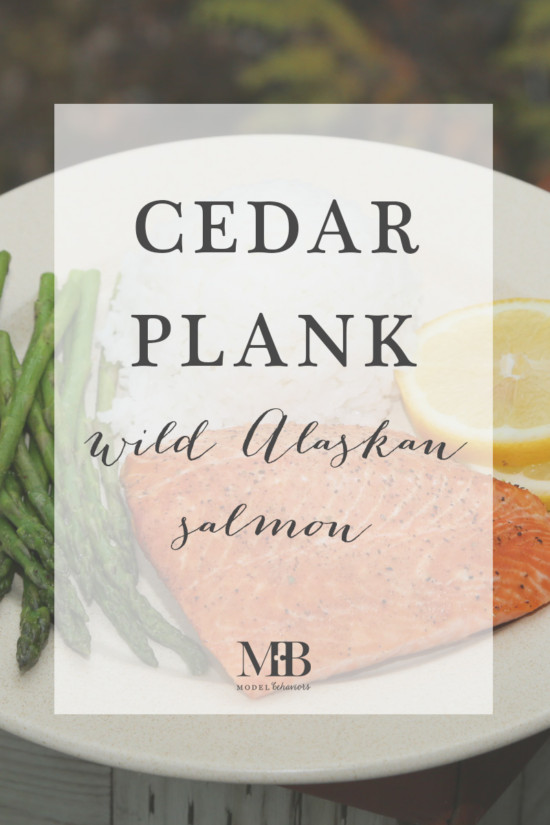I’m excited to share a recipe that reflects a couple of my favorite hometown resources—wild Alaskan salmon and the aromatic Alaskan Yellow Cedar. Wild salmon has to be one of the healthiest foods around. It’s an excellent source of protein chock full of vitamins and omega-3 fatty acids. My mom always told me that salmon was “brain food” and that eating it would make me smarter. Now I’m telling my kids the same thing!

Cedar plank salmon is my absolute favorite way to cook salmon. It’s actually a very simple technique with results that are sure to impress the taste buds of land-lovers and seasoned fishermen alike. The moment I unwrap the cedar boards, the smell reminds me of my time in Southeast Alaska. Cedar trees are one of the main species of trees that grow in the Tongass National Forest. They can grow to one hundred feet in height and are used for everything from building homes to beautiful Native art including woven baskets, ceremonial blankets, and impressively carved totem poles.

You can easily find cedar boards at your favorite grocery store or online. The first and most important step is to unwrap and soak your boards for at least an hour before you fire up the grill. I like to fill a cookie sheet full of water and slide the boards in, placing a heavy mug on top to ensure that the board is fully submerged.

If you’re using frozen fish, please make sure it has thawed entirely. Cooking frozen salmon is NOT a good idea—the results are absolutely awful. It’s important to take your fresh or thawed filets out of the fridge a good fifteen minutes or so before you’re going to cook. If the salmon is too cold when you put it on a hot grill, it will turn tough and you’ll miss out on the flakey, moist quality. I’ve learned this the hard way.

Before placing your filets on the cedar planks, rinse them under cold water and gently pat dry with paper towels. Place your filets skin side down on the planks and season with the Four Seasons blend.


This seasoning blend is simple and tasty on both fish and veggies. I call it Four Seasons because it has four ingredients and it’s great for year-round grilling. It’s simple to put together, and once you try it, you can adjust the amounts according to your preference. It’s also fun to have the kids help make it. It’s sort of like a sand art project. Give them a jar and funnel and let them have fun measuring out the seasonings and then shaking to combine.
When your grill is hot (500 degrees), place the cedar planks in the center of the grill and cover. Cook for approximately fifteen minutes. The time will vary depending on the thickness of your filets. (The Coho salmon filets that are pictured took just twelve minutes.) You can test them by placing your finger on top of the salmon and pressing down. It should feel firm, and the thin areas near the belly and tail should begin to break into clean flakes.

When your fish is done, remove it from the grill and cover with aluminum foil. Serve directly from the cedar planks. Slide your serving tool between the skin and the meat, leaving the skin on the plank. My family traditionally serves grilled salmon with a green veggie (asparagus or broccoli), white rice, and soy sauce. However, for a healthier option you can substitute brown rice or your favorite quinoa recipe. I’ve also included my easy Campfire Asparagus recipe below.

Last summer, my brother and husband were heading out on an overnight camping and fishing trip. I washed, trimmed and seasoned asparagus with the Four Seasons blend and drizzled it with extra-virgin olive oil. I wrapped it up in aluminum foil and secured it in a zip-lock bag to send with them. The boys threw it on the campfire the next night and claimed it was the best asparagus EVER! Now, having been camping in Southeast Alaska myself, I know that sometimes after hours and hours of fishing or hiking you can get so hungry that whatever you cook, as long as it’s warm, may sometimes taste like the best thing ever. However, I’m just going to go with it and agree. I hope you do too!

- 2 Cedar Planks
- 4 1-lb Wild Alaskan Salmon filets
- Four Seasons Blend (recipe in photo above)
- Soak cedar planks in water for at least an hour.
- Heat grill to 500 degrees.
- Rinse salmon filets under cold water and pat dry with paper towels.
- Remove cedar planks from water and drain.
- Place two salmon filets on each plank, skin side down.
- Season the tops of the filets generously with the Four Seasons blend.
- Place cedar planks in the center of the grill.
- Cover the grill and cook until the top of the salmon feels firm when you press it with your finger and begins to break into clean flakes on the edges (approximately 12 to 20 minutes depending on the thickness of the filet).
- Remove planks from grill and tent with aluminum foil for a few minutes.
- Serve salmon from planks sliding a spatula between the skin and filet, leaving the skin on the plank.
- 2 bunches of asparagus
- Extra Virgin Olive Oil
- Four Seasons Blend
- Snap one spear of asparagus to determine the natural breaking point.
- Use this spear to measure where to trim the asparagus to remove the woody ends.
- Wash trimmed spears under cold water and let drain.
- Place asparagus on a large square of aluminum foil.
- Drizzle with extra virgin olive oil and sprinkle generously with the Four Seasons blend.
- Fold up the sides and ends of the aluminum foil to make a pouch.
- Place directly on coals of a campfire or on a hot grill for 5 minutes.
- Use tongs to remove and let cool for a minute or two. Serve immediately.
Enjoy!






